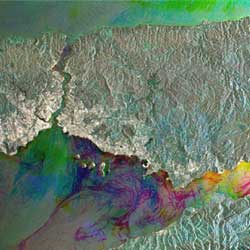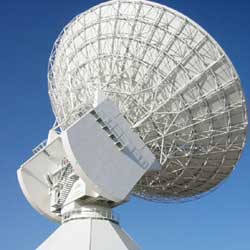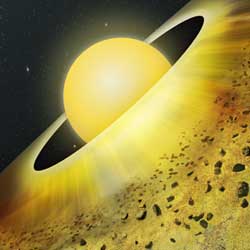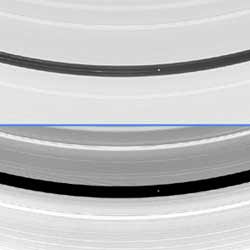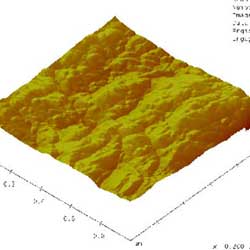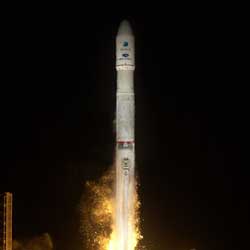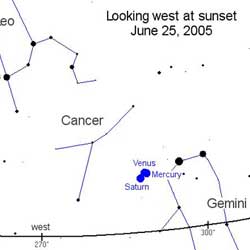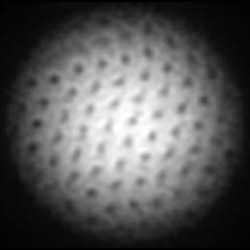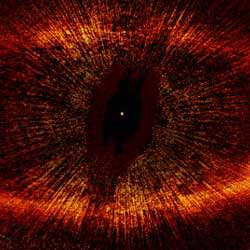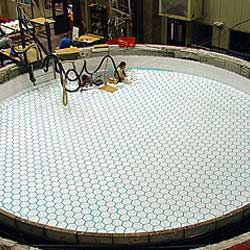
Workers completing the mold of the 8.4 metre mirror for the Giant Magellan Telescope mirror. Image credit: Lori Stiles/UA. Click to enlarge.
The University of Arizona’s Steward Observatory Mirror Lab is pre-firing its huge spinning furnace and inspecting tons of glass for casting a first 8.4-meter (27-foot) diameter mirror for the Giant Magellan Telescope (GMT). The casting is scheduled for Saturday, July 23.
With this milestone step, the GMT becomes the first extremely large ground-based telescope to start construction.
The completed GMT telescope primary mirror will consist of six 8.4-meter off-axis mirrors surrounding a seventh, on-axis central mirror. (An off-axis mirror focuses light at an angle away from its axis, unlike a symmetrical mirror that focuses light along its axis.) This arrangement will give the GMT four-and-one-half times the collecting area of any current optical telescope and the resolving power of a 25.6-meter (84-foot) diameter telescope, or 10 times the resolution of the Hubble Space Telescope.
‘Spin-casting’ single-piece telescope mirrors that are giant, stiff yet lightweight is an ingenious, awesome process that was conceived and developed by University of Arizona Regents’ Professor of astronomy J. Roger P. Angel. Casting giant monolithic mirrors is accomplished at only one place in the world — the Steward Observatory Mirror Laboratory.
The casting team, headed by Randy Lutz, installed about 50 cores a day for a total 1,681 cores during seven weeks in April – May. The team bolted each core at precisely measured angles to hearth tile and adjoining cores in this operation. The crew daubed all the glued junctures with blue “smurf” – a concoction the color of the blue smurf cartoon characters — to prevent glass from sticking to the mold.
At this point, the mold holds 17,000 pounds of hearth tiles, 16,000 pounds in fiber tub walls, and 15,000 pounds of cores and pins. The casting team has now cleaned and inspected the completed mold, lowered the furnace cover into place, and begun pre-firing on June 16.
Team members actively ‘pilot’ the furnace by computer as temperatures ramp up during the first 8 days of the heating process, then shut power off to complete the two-week pre-firing. Pre-firing centers core glue joints, burns out any impurities and stresses the mold. The casting team will inspect the mold for any needed repairs after pre-firing.
Some of the most visually stunning steps in casting are glass inspection and loading. The team began inspecting 90 shipping crates of glass on June 24. Glass loading is scheduled for the second week of July, said Steve Miller, Mirror Lab manager.
The 40,000 pounds of borosilicate glass that will make the 27-foot diameter (8.4 meter) GMT mirror comes from Ohara Glassworks in Japan. Ohara made the glass from sand that comes from the gulf coast of Florida.
The Mirror Lab will start heating the furnace July 18. It takes six days for the glass to reach peak temperature at 2,150 degrees Fahrenheit (1178 Celsius). At this temperature, the glass begins to flow like honey at room temperature. The thick liquid glass flows between the hexagonal cores in the mold to create a “honeycomb” structure. The final honeycomb mirror blank will weigh about a fifth as much as a solid glass mirror of its size.
The bearings on the rotating furnace will turn a 100-ton load during spincasting. The furnace can be supplied with up to 1.1 Megawatts of electricity during casting — enough to power an average 750 to 1,100 Tucson households, depending on the time of year.
The oven’s rotation rate determines the depth of the curve spun into the shape of the mirror, or the mirror’s focal length. The GMT mirror will spin 5 times a minute, slower than the two 8.4-meter mirrors the Lab made for the Large Binocular Telescope (LBT), because the off-axis GMT mirror is to be a shallower, longer focal-length mirror than the symmetric LBT primaries.
“This is a new epoch for astronomy,” Richard Meserve, president of the Carnegie Institution, said. “The fabrication of the off-axis mirror is a path-breaking event that will advance scientific discovery. Everyone in the eight-member GMT consortium is excited that we’re in production.”
The Giant Magellan Telescope consortium currently includes the Carnegie Observatories, Harvard University, Smithsonian Astrophysical Observatory, University of Arizona, University of Michigan, Massachusetts Institute of Technology, University of Texas at Austin, and Texas A & M University.
“The fact that we are already in production is directly related to the successful technology developed for the twin 6.5-meter (21-foot) Magellan telescopes at Carnegie’s Las Campanas Observatory in Chile,” said Matt Johns, assistant director of the Carnegie Observatories and GMT project manager. “The Magellan telescopes have proved to be the best natural imaging telescopes on the ground.”
Mirror cooling is a carefully controlled process that will take 11 to 12 weeks. After the mirror is completely cooled, the lab will wash the ceramic cores out of the mirror’s glass honeycomb cells. Then the mirror will be ground and polished to an accuracy of plus-or-minus 15 to 20 nanometers (a nanometer is a billionth of a meter). The mirror will be coated with a layer of reflective aluminum only 100 nanometers thick at the observatory site.
The GMT is slated for completion in 2016 at a site in northern Chile. With its powerful resolution and enormous collecting area, it will be able to probe the most important questions in astronomy, including the birth of stars and planetary systems in our Milky Way, the mysteries of black holes, and the genesis of galaxies.
Detailed information about the GMT design and science goals is online at http://www.gmto.org/
Original Source: UA News Release

